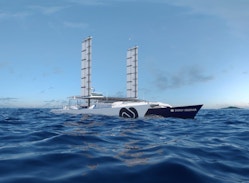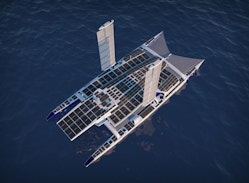The 2019 new features of Energy Observer
Already 10,326 nautical miles covered by Energy Observer. Having set out from Saint-Malo in June 2017, the first hydrogen vessel around the world has made 33 stopovers and has been to 14 countries, navigating in France and the Mediterranean with no emissions of greenhouse gases or fine particles. Returning to Saint-Malo, its home port, the vessel will undergo important changes to be ready for its next challenge: Northern Europe. These changes were revealed at a press conference on December 10 in the Energy Observer village at Salon Nautic 2018.

Although it’s an inexhaustible resource at sea, wind is still difficult to exploit for large scale maritime transport.
In its role as an experimental vessel, Energy Observer has set its mission to test all of the available and promising solutions. During its first navigation seasons, Energy Observer experimented with two vertical-axis wind turbines for production, and a traction wing to reduce energy consumption.
In 2019, the vessel will test a completely new system combining the advantages of the former system with a new one: a wind propeller. The Oceanwings wings® are going to reduce the vessel’s energy consumption, accelerate its speed, and above all, enable it to produce energy and hydrogen while navigating.

Energy Observer 3D image with Oceanwings®
Others optimizations
Increasing the surface of solar panels
With an added 27m2 of supplementary panels, increasing the total surface from 141 to 168 m2 for a maximum potential of 28 kWc. These panels will basically be cells encased in flexible, conformable and anti-slip panels, the same type of panel that can be placed on any vessel deck.
Optimization of thermal storage
Upgrading the intermittency of 3 heat storage means (fuel cell, electrolyser, and converter) to reach 20 kWh to heat the central nacelle and produce hot water. And therefore further reducing the overall consumption onboard.